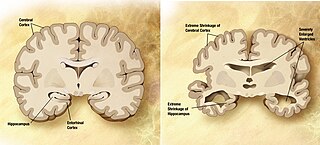| AD16 | |||||||||||||||||||||||||||||||||||||||||||||||||||
|---|---|---|---|---|---|---|---|---|---|---|---|---|---|---|---|---|---|---|---|---|---|---|---|---|---|---|---|---|---|---|---|---|---|---|---|---|---|---|---|---|---|---|---|---|---|---|---|---|---|---|---|
 | |||||||||||||||||||||||||||||||||||||||||||||||||||
| Identifiers | |||||||||||||||||||||||||||||||||||||||||||||||||||
| Aliases | Alzheimer disease 16 | ||||||||||||||||||||||||||||||||||||||||||||||||||
| External IDs | GeneCards: | ||||||||||||||||||||||||||||||||||||||||||||||||||
| |||||||||||||||||||||||||||||||||||||||||||||||||||
| Wikidata | |||||||||||||||||||||||||||||||||||||||||||||||||||
| |||||||||||||||||||||||||||||||||||||||||||||||||||
Alzheimer disease 16 is a protein that in humans is encoded by the AD16 gene. [2]
| AD16 | |||||||||||||||||||||||||||||||||||||||||||||||||||
|---|---|---|---|---|---|---|---|---|---|---|---|---|---|---|---|---|---|---|---|---|---|---|---|---|---|---|---|---|---|---|---|---|---|---|---|---|---|---|---|---|---|---|---|---|---|---|---|---|---|---|---|
 | |||||||||||||||||||||||||||||||||||||||||||||||||||
| Identifiers | |||||||||||||||||||||||||||||||||||||||||||||||||||
| Aliases | Alzheimer disease 16 | ||||||||||||||||||||||||||||||||||||||||||||||||||
| External IDs | GeneCards: | ||||||||||||||||||||||||||||||||||||||||||||||||||
| |||||||||||||||||||||||||||||||||||||||||||||||||||
| Wikidata | |||||||||||||||||||||||||||||||||||||||||||||||||||
| |||||||||||||||||||||||||||||||||||||||||||||||||||
Alzheimer disease 16 is a protein that in humans is encoded by the AD16 gene. [2]

Clusterin is a 75-80 kDa disulfide-linked heterodimeric protein associated with the clearance of cellular debris and apoptosis. In humans, clusterin is encoded by the CLU gene on chromosome 8. CLU is a molecular chaperone responsible for aiding protein folding of secreted proteins, and its three isoforms have been differentially implicated in pro- or antiapoptotic processes. Through this function, CLU is involved in many diseases related to oxidative stress, including neurodegenerative diseases, cancers, inflammatory diseases, and aging.

(See also: List of proteins in the human body)

Amyloid-beta precursor protein (APP) is an integral membrane protein expressed in many tissues and concentrated in the synapses of neurons. It functions as a cell surface receptor and has been implicated as a regulator of synapse formation, neural plasticity, antimicrobial activity, and iron export. It is coded for by the gene APP and regulated by substrate presentation. APP is best known as the precursor molecule whose proteolysis generates amyloid beta (Aβ), a polypeptide containing 37 to 49 amino acid residues, whose amyloid fibrillar form is the primary component of amyloid plaques found in the brains of Alzheimer's disease patients.

Major prion protein(PrP) is encoded in the human body by the PRNP gene also known as CD230 (cluster of differentiation 230). Expression of the protein is most predominant in the nervous system but occurs in many other tissues throughout the body.

Apolipoprotein E (Apo-E) is a protein involved in the metabolism of fats in the body of mammals. A subtype is implicated in the Alzheimer's disease and cardiovascular diseases. It is encoded in humans by the gene APOE.

A neurodegenerative disease is caused by the progressive loss of structure or function of neurons, in the process known as neurodegeneration. Such neuronal damage may ultimately involve cell death. Neurodegenerative diseases include amyotrophic lateral sclerosis, multiple sclerosis, Parkinson's disease, Alzheimer's disease, Huntington's disease, multiple system atrophy, and prion diseases. Neurodegeneration can be found in the brain at many different levels of neuronal circuitry, ranging from molecular to systemic. Because there is no known way to reverse the progressive degeneration of neurons, these diseases are considered to be incurable; however research has shown that the two major contributing factors to neurodegeneration are oxidative stress and inflammation. Biomedical research has revealed many similarities between these diseases at the subcellular level, including atypical protein assemblies and induced cell death. These similarities suggest that therapeutic advances against one neurodegenerative disease might ameliorate other diseases as well.

Beta-secretase 1, also known as beta-site amyloid precursor protein cleaving enzyme 1, beta-site APP cleaving enzyme 1 (BACE1), membrane-associated aspartic protease 2, memapsin-2, aspartyl protease 2, and ASP2, is an enzyme that in humans is encoded by the BACE1 gene. Expression of BACE1 is observed mainly in neurons.

Alpha 1-antichymotrypsin is an alpha globulin glycoprotein that is a member of the serpin superfamily. In humans, it is encoded by the SERPINA3 gene.

Presenilins are a family of related multi-pass transmembrane proteins which constitute the catalytic subunits of the gamma-secretase intramembrane protease protein complex. They were first identified in screens for mutations causing early onset forms of familial Alzheimer's disease by Peter St George-Hyslop. Vertebrates have two presenilin genes, called PSEN1 that codes for presenilin 1 (PS-1) and PSEN2 that codes for presenilin 2 (PS-2). Both genes show conservation between species, with little difference between rat and human presenilins. The nematode worm C. elegans has two genes that resemble the presenilins and appear to be functionally similar, sel-12 and hop-1.

Neurogranin is a calmodulin-binding protein expressed primarily in the brain, particularly in dendritic spines, and participating in the protein kinase C signaling pathway. Neurogranin is the main postsynaptic protein regulating the availability of calmodulin, binding to it in the absence of calcium. Phosphorylation by protein kinase C lowers its binding ability. NRGN gene expression is controlled by thyroid hormones. Human neurogranin consists of 78 amino acids.

Multidrug resistance-associated protein 1 (MRP1) is a protein that in humans is encoded by the ABCC1 gene.

ATP-binding cassette sub-family A member 7 is a protein that in humans is encoded by the ABCA7 gene.

Brain mitochondrial carrier protein 1 is a protein that in humans is encoded by the SLC25A14 gene.

Translocase of outer mitochondrial membrane 40 homolog (yeast), also known as TOMM40, is a protein which in humans is encoded by the TOMM40 gene.

Formin-like protein 2 is a protein that in humans is encoded by the FMNL2 gene.
Early-onset Alzheimer's disease (EOAD), also called Younger-onset Alzheimer's disease (YOAD), is Alzheimer's disease diagnosed before the age of 65. It is an uncommon form of Alzheimer's, accounting for only 5–10% of all Alzheimer's cases. About 60% have a positive family history of Alzheimer's and 13% of them are inherited in an autosomal dominant manner. Most cases of early-onset Alzheimer's share the same traits as the "late-onset" form and are not caused by known genetic mutations. Little is understood about how it starts.

Mitochondrially encoded 16S RNA is the mitochondrial large subunit ribosomal RNA that in humans is encoded by the MT-RNR2 gene. The MT-RNR2 gene also encodes the Humanin polypeptide that has been the target of Alzheimer's disease research.

Neutral ceramidase B also known as non-lysosomal ceramidase B or N-acylsphingosine amidohydrolase 2B or ASAH2B is a ceramidase enzyme which in humans is encoded by the ASAH2B gene.

Rudolph Emile 'Rudy' Tanzi is the Joseph P. and Rose F. Kennedy Professor of Neurology at Harvard University, Vice-chair of Neurology, Director of the Genetics and Aging Research Unit, and co-director of the Henry and Allison McCance Center for Brain Health at Massachusetts General Hospital (MGH). Dr. Tanzi has been investigating the genetics of neurological disease since the 1980s when he participated in the first study that used genetic markers to find a disease gene. Dr. Tanzi co-discovered all three familial early-onset Alzheimer's disease (FAD) genes and several other neurological disease genes including that responsible for Wilson’s disease. As the leader of the Cure Alzheimer's Fund Alzheimer's Genome Project, Dr. Tanzi has carried out multiple genome wide association studies of thousands of Alzheimer's families leading to the identification of novel AD candidate genes, including CD33 and the first two rare mutations causing late-onset AD in the ADAM10 gene. His research on the role of zinc and copper in AD has led to clinical trials at Prana Biotechnology. He is also working on gamma secretase modulators for the prevention and treatment of Alzheimer's. He also serves as Chair of the Cure Alzheimer's Fund Research Leadership Group and Director the Cure Alzheimer's Fund Alzheimer's Genome Project™.

Leukocyte immunoglobulin-like receptor subfamily A member 5 (LILR-A5) also known as CD85 antigen-like family member F (CD85f), immunoglobulin-like transcript 7 (ILT-7), and leukocyte immunoglobulin-like receptor 9 (LIR-9) is a protein that in humans is encoded by the LILRA5 gene. This gene is one of the leukocyte receptor genes that form a gene cluster on the chromosomal region 19q13.4. Four alternatively spliced transcript variants encoding distinct isoforms have been described.